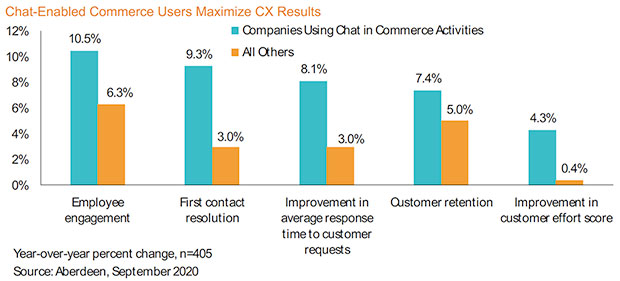More consumers are shopping via phones and other mobile devices, and companies that use chat with commerce are reaping rewards while improving the customer experience.
New commerce research reveals that at least two-thirds of firms using chat apps such as WhatsApp and WeChat see greater commerce gains than competitors that do not. These gains include year-over-year revenue growth of 75 percent, greater annual growth in cross-sell/upsell revenue of 89 percent, a YoY bump in customer retention rates of 48 percent, and an almost two times greater YoY increase in marketing ROI.
Research IT firm Aberdeen recently surveyed top global IT executives across a range of business verticals to help quantify the impacts of chat deployments on their business. The research shows significant benefits to customer experience metrics and other top key performance indicators of businesses utilizing chat for customer service and commerce activities.
In-Chat Transactions
The digitalization of commerce activities continues to grow with increasing speed and diversity. This is the result of growing numbers of consumers utilizing mobile devices — smartphones, tablets, and wearables.
Buyers are using these devices to interact with businesses trending across almost all consumer-related industries. This new marketing strategy is impacting the retail, CPG, hospitality, transportation, banking, and telecommunications markets.
Think of chat commerce as a method by which businesses can set up rich and engaging information exchanges with consumers. According to Pieter de Villiers, CEO and co-founder of Clickatell, this enables them to move from inquiry to a commercial transaction without ever needing to leave the chat app.
“Thousands of businesses are now using chat to onboard, offer, and cross-sell to customers,” he told CRM Buyer.
Report Findings Credible
According to Jen Snell, vice president for product marketing for Verint, Aberdeen’s research supports the results Verint’s Intelligent Self-Service enterprise customers have recognized in recent years.
“One surprisingly simple reason that we found chat works so well for the cross-sell and upsell situations is that the assistants actually ask the questions,” she told CRM Buyer.
Moreover, with chatbots, customers are less likely to feel that they are being sold to with upsell offers. Instead, customers feel they are simply hearing about available options, Snell added.
“That makes a dramatic difference in the effectiveness of the cross-sell and upsell,” she said.
Familiar Technology
Culturally, Verint sees consumers becoming more comfortable and familiar with chat technology for business. Its use is at a point where customers expect quality chat experiences and know-how to navigate them effectively.
“We also have to remember that for a growing number of customers this technology is not new. It is something that has always been there. Members of Generation Z were born into a culture of advanced technology,” said Snell.
The oldest Gen Zers were 10 years old when the iPhone was launched. They had 3G and 4G cellular access before they even reached high school, and on-demand content has, for them, always been the rule and not the exception. It makes sense that they would expect to — and likely even prefer — to engage in commerce over chat, she observed.
At the same time, technology has also improved significantly. Today’s chat technology has better natural language processing and intent-understanding capabilities that make these experiences more effective for users.
“So what we are seeing is not an unexpected trend, but rather a solidification and proof of a move to chat interactions for business,” Snell remarked.
US Firms Behind the Chat Curve
Chat commerce pioneer Clickatell sees digital transformation succeeding as chat moves from self-service to actual commerce. To date, companies outside the U.S. are leading in this arena, but Apple and Google, as well as others, are making advancements.
Aberdeen’s March 2020 survey shows firms in the Asia-Pacific (APAC), Europe, Middle East, and Africa (EMEA) regions currently have the lead in chat adoption, with 77 percent and 76 percent using it. These regions are followed by firms in North America and Latin America (LATAM), with 67 percent and 63 percent, respectively, using one or more of the chat capabilities.
According to de Villiers, the push in those regions was largely due to a lack of smartphone penetration and the use of mobile apps. Add to that the high cost of mobile data combined with poor reach in terms of broadband WiFi.
Chat commerce has blossomed outside of the U.S. because text messaging is expensive. Consumers opted to use the less expensive, IP-based chat apps to communicate with each other, he explained.
Chat’s Where It’s At
Chat adoption across all regions has been steadily increasing, with companies continuously enriching and fine-tuning their chat capabilities. Consumer expectations are the driving force behind modern-day commerce activities, added Aberdeen’s report.
“It, however, soon became evident that chat is not a second-class alternative but a first-class customer experience in terms of convenience,” de Villiers told CRM Buyer.
Now, with AI-powered bots and advanced assisted chat desks, chat commerce is poised to go mainstream in the US. de Villiers already sees increased inquiries as brands in the U.S. look to reach their customers where they are most comfortable in a more convenient manner.
“Frankly, that is in chat,” he noted.
WhatsApp has over 2 billion users worldwide, while other chat apps such as WeChat and Telegram have 2 to 3 billion users.
“These applications are more interactive and feature-rich than SMS text messaging, and businesses have come to understand that these apps can be go-to platforms for commerce as well,” de Villiers said.
Integrated Approach Needed
Chat commerce has been slower to catch on due to consumers being well-served through mobile apps. However, app downloads are declining, and consumers spend less time on branded apps and more time on chat, according to de Villiers.
In addition, the chat commerce experience has only recently become very compelling and more convenient. That credit goes to the advances made in robotic process automation (RPA) and AI.
De Villiers noted that the Aberdeen report outlines several key building blocks chat-enabled commerce users should establish to maximize performance.
Firms do not think of chat-enabled commerce as a purely technology-driven initiative. To get the most return from chat investments, firms must support their activities with the capabilities categorized across these three points:
- Enrich chat-enabled commerce through context
- Minimize complexity and hyper-personalize chat activities
- Regularly gauge performance to drive continuous improvements and keep up with changing buyer needs
Using chat platforms for business requires firms to determine which activities across the three building blocks are not working well. Once they figure that out, fix them by implementing the missing capabilities, de Villiers directed.
Inevitable Time Frame
The trend toward a chat economy has already started. A strong pipeline of innovative brands looking to launch chat commerce capability is now waiting, de Villiers observed.
“We believe the market will be moving from a current chat commerce innovator phase to an early majority phase during the next 18 to 24 months,” he said.
However, de Villiers does not think chat should or will become the primary channel for marketing. In fact, he prefers it if chat platforms refrained from such a goal.
As consumers, chat platforms are very important messaging and engagement channels to get things done. Organizing and turning it into a marketing-focused channel will not serve consumers well.
“However, we do believe chat commerce will happen everywhere and that being able to pay bills, upgrade travel, and resolve customer queries via our favorite chat platform are powerful things,” he insisted.

























































